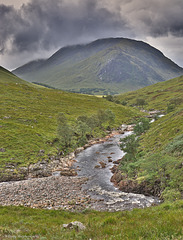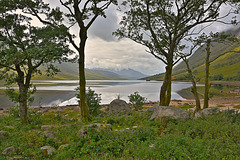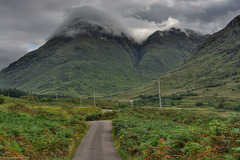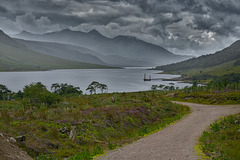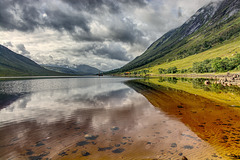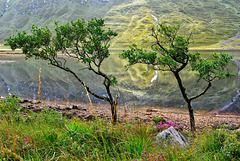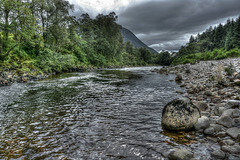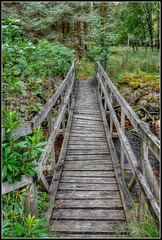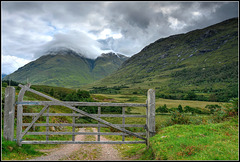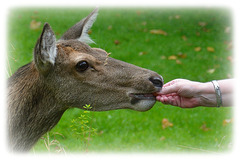
Glen Etive
Folder: Scotland
Glen Etive (Scottish Gaelic: Gleann Èite) is a glen in the Highlands of Scotland. The River Etive (Scottish Gaelic: Abhainn Èite) rises on the peaks surrounding Rannoch Moor, with several tributary streams coming together at the Kings House Hotel, at the head of Glen Coe. From the Kings House, the Etive flows for about 18 km, reaching the sea loch, Loch Etive. The river and its tributaries are pop…
(read more)
Turbulent clouds over Glen Etive
| |
|
|
|
Glen Etive (Scottish Gaelic: Gleann Èite) is a glen in the Highlands ( Argyll and Bute) of Scotland. A single track road, widely regarded as one of the most picturesque roads in all of Scotland, runs from the Kings House Hotel down the glen for some 11 ml/18 km. This meandering road was actually built to serve the tiny hamlets of Dalness and Gualachulainng and several houses and farms. This road ends at the head of the loch, though rough tracks continue along both shores.
River Etive
| |
|
|
|
The River Etive (Scottish Gaelic: Abhainn Èite) rises on the peaks surrounding Rannoch Moor, with several tributary streams coming together at the Kings House Hotel, at the head of Glen Coe. From the Kings House, the Etive flows through Glen Etive for about 11ml/18 km, reaching the sea at Loch Etive.
Loch Etive
| |
|
|
|
The point at which the river enters the loch
Loch Etive (Scottish Gaelic, Loch Eite) is a 30 km sea loch in Argyll and Bute, Scotland. It reaches the sea at Connel, 5 km north of Oban. It measures 31.6 km (19 3⁄4 miles) long and from 1.2 km ( 3⁄4 mile) to 1.6 km (1 mi) wide. Its depth varies greatly, up to a maximum of 150 m (490 ft).
The River Etive drains into Loch Etive from its source near Kingshouse on Glencoe, Rannoch Moor. A small, single track road runs alongside the river for its 11 ml/18 km course to the loch – this road is widely regarded as one of the most picturesque roads in all of Scotland.
Wanderings in Glen Etive (4 x PiPs)
| |
|
|
|
The River Etive rises on the peaks surrounding Rannoch Moor, with several tributary streams coming together at the Kings House Hotel, at the head of Glen Coe. The river flows through Glen Etive, draining into Loch Etive, a sea loch.
The river was peaceful when this picture was taken from the 'garden' of our rented cottage. After a period of heave rain the level can rise by about a metre over a fairly short period of time resulting in a much more active scene.
The PiP shows River Etive with Buachaille Etive Beag in the distance.
A small, single track road runs alongside the river for its 18km course to the loch – this road is widely regarded as one of the most picturesque roads in all of Scotland.
The pictures above and below show a small section of this road at the lower end of the glen, about 2km from the head Loch Etive.
The point at which the river enters Loch Etive
A shroud of Cloud on Stob Dubh and Beinn Ceitlein…
A Long and Winding Road
The Approaching Storm - Loch Etive
| |
|
|
|
Loch Etive (Scottish Gaelic, Loch Eite) is a 30 km sea loch in Argyll and Bute, Scotland. It reaches the sea at Connel, 5 km north of Oban. It measures 31.6 km (19 3⁄4 miles) long and from 1.2 km ( 3⁄4 mile) to 1.6 km (1 mi) wide. Its depth varies greatly, up to a maximum of 150 m (490 ft).
Colours of Loch Etive
| |
|
|
|
Perhaps better enlarged
Loch Etive (Scottish Gaelic, Loch Eite) is a 30 km sea loch in Argyll and Bute, Scotland. It reaches the sea at Connel, 5 km north of Oban. It measures 31.6 km (19 3⁄4 miles) long and from 1.2 km ( 3⁄4 mile) to 1.6 km (1 mi) wide. Its depth varies greatly, up to a maximum of 150 m (490 ft).
The River Etive drains into Loch Etive from its source near Kingshouse on Glencoe, Rannoch Moor. A small, single track road runs alongside the river for its 18km course to the loch – this road is widely regarded as one of the most picturesque roads in all of Scotland. The loch water is coloured by the presence of peat in the water of the River Etive, which enters the loch at this point, mixing with the seawater.
From 1847 a steamer service from Oban carried passengers to the now derelict pier (just visible at centre of picture) at the north end of the loch, linking to a carriage service that took tourists up Glen Etive to see Glen Coe. A later structure, located near the original jetty, can be used for the transportation of timber by sea in the form of logs harvested from the forestry on the hills in Glen Etive.
The name Etive is believed to mean "little ugly one" from the Gaelic goddess associated with the loch. It heads east for half its length alongside the main road and rail link to Oban, before heading northeast into mountainous terrain seen here. The narrow mouth of the loch results in its most unusual feature, the Falls of Lora. Part of the north bank has been designated a Special Area of Conservation in particular due to old sessile oak woods. Surprisingly, a small colony of around 20 common seals is resident in Loch Etive.
By the shore of Loch Etive
| |
|
|
|
The river Etive enters the loch of the same name (…
| |
|
|
|
The River Etive rises on the peaks surrounding Rannoch Moor, with several tributary streams coming together at the Kings House Hotel, at the head of Glen Coe. The river flows through Glen Etive, draining into Loch Etive (sea loch).
A small, single track road runs alongside the river for its 18km course to the loch – this road is widely regarded as one of the most picturesque roads in all of Scotland.
Dark waters run deep.....
| |
|
|
|
Best enlarged
The River Etive rises on the peaks surrounding Rannoch Moor, with several tributary streams coming together at the Kings House Hotel, at the head of Glen Coe. The river flows through Glen Etive, draining into Loch Etive.
The river was peaceful when this picture was taken. After a period of heave rain the level rises by about a metre over a fairly short period of time resulting in a much more active scene.
A small, single track road runs alongside the river for its 18km course to the loch – this road is widely regarded as one of the most picturesque roads in all of Scotland.
Tranquility....
HFF from Glen Etive, Argyll, Scotland
| |
|
|
|
Best enlarged
The bridge is not quite a rickety as might appear. Although the deck is rather fragile looking, it is supported from below by two substantial spruce tree trunks secured into the banks of the stream. Yes I did put the bridge to the test;-))
Cloud capped Beinn Ceitlein, Glen Etive
| |
|
|
|
Best enlarged
The five bar gate prevents vehicular access to the estate track but allows walkers easy access (via a bridge) to the hills and glens on far side of the River Etive.
Loch Etive Jetty, Glen Etive, Argyll, Scotland (1…
| |
|
|
|
This jetty can be used for the transportation of timber by sea, harvested from the forestry on the hills in Glen Etive. As can be seen from the two pictures, the current jetty is close to the location that the Victorian era jetty would have occupied.
It is perhaps worth noting that in the intervening approximately 130 years between the two pictures, nothing seem seems to have changed on the far shore of the loch.
A steamer, (see PiP) believed to be the "Osian" (1885 - 1913), moored at a pier on Loch Etive. Since 1877 a tour had run from Oban sailing the 17 miles up Loch Etive (via Connell where it opened to the sea), with coach connections to Tyndrum and Ballachulish Railway Stations. From a pier at the north end of Loch Etive tourists were able to link with a carriage service which took them up Glen Etive to see Glen Coe, a distance of some 17-18 miles.
For the Victorian photograph my thanks to Don001 at:
the-lothians.blogspot.co.uk/2012/10/late-victorian-edwardian-era-scottish.html
Buachaille Etive Mòr beneath a moody sky
| |
|
|
|
Best enlarged
Buachaille Etive Mòr (Scottish Gaelic: Buachaille Èite Mòr, meaning "the herdsman of Etive"), generally known to climbers simply as The Buachaille, is a mountain at the head of Glen Etive in the Highlands of Scotland. Its pyramidal form, as seen from the A82 road when travelling towards Glen Coe, makes it one of the most recognisable mountains in Scotland, and one of the most depicted on postcards and calendars.
Buachaille Etive Mòr takes the form of a ridge nearly five miles (8 km) in length, almost entirely encircled by the River Etive and its tributaries. The ridge contains four principal tops: from north-east to south-west these are Stob Dearg (1022 m), Stob na Doire (1011 m), Stob Coire Altruim (941 m) and Stob na Bròige (956 m).
A Helping Hand
| |
|
|
|
Reflections on Loch Etive, Argyll, Scotland
| |
|
|
|
Picture taken at the point at which the River Etive enters the loch.
Loch Etive (Scottish Gaelic, Loch Eite) is a 30 km sea loch in Argyll and Bute, Scotland. It reaches the sea at Connel, 5 km north of Oban. It measures 31.6 km (19 3⁄4 miles) long and from 1.2 km ( 3⁄4 mile) to 1.6 km (1 mi) wide. Its depth varies greatly, up to a maximum of 150 m (490 ft).
The River Etive drains into Loch Etive from its source near Kingshouse on Glencoe, Rannoch Moor. A small, single track road runs alongside the river for its 18km course to the loch – this road is widely regarded as one of the most picturesque roads in all of Scotland.
From 1847 a steamer service from Oban carried passengers to a pier in the area of the pier now used for the loading of logs onto ships (just visible at right of picture) at the north end of the loch. From there the passengers would board a carriage service that took tourists up Glen Etive to see Glen Coe.
The name Etive is believed to mean "little ugly one" from the Gaelic goddess associated with the loch. It heads east for half its length alongside the main road and rail link to Oban, before heading northeast into mountainous terrain. The narrow mouth of the loch results in its most unusual feature, the Falls of Lora. Part of the north bank has been designated a Special Area of Conservation in particular due to old sessile oak woods. Surprisingly, a small colony of around 20 common seals is resident in Loch Etive.
Jump to top
RSS feed- Latest items - Subscribe to the latest items added to this album
- ipernity © 2007-2024
- Help & Contact
|
Club news
|
About ipernity
|
History |
ipernity Club & Prices |
Guide of good conduct
Donate | Group guidelines | Privacy policy | Terms of use | Statutes | In memoria -
Facebook
Twitter


